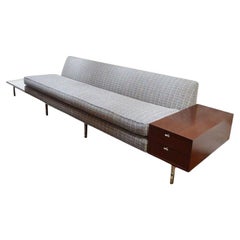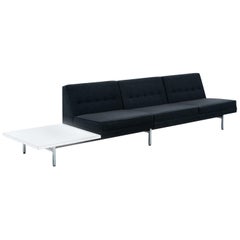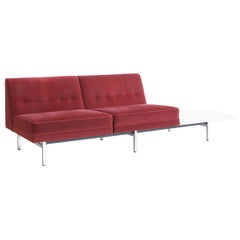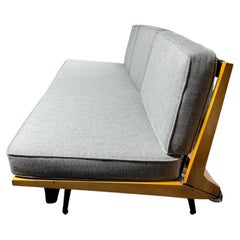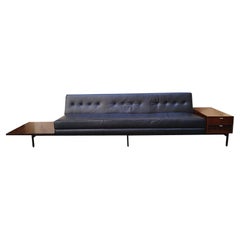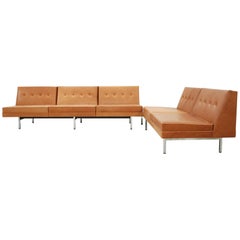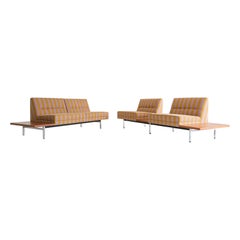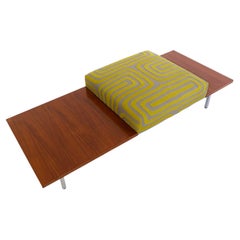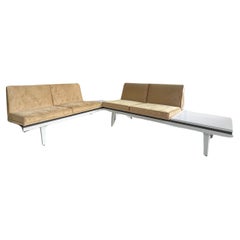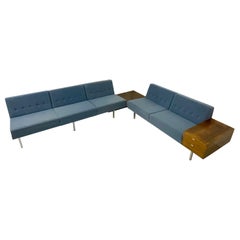George Nelson Modular Sofa
20th Century American Sofas
Chrome
Mid-20th Century American Mid-Century Modern Sofas
Steel
Vintage 1960s American Mid-Century Modern Sofas
Steel, Chrome
Vintage 1950s American Mid-Century Modern Sofas
Steel
Vintage 1960s American Mid-Century Modern Sofas
Metal
Vintage 1950s American Mid-Century Modern Sofas
Metal
Vintage 1950s American Mid-Century Modern Sofas
Metal
Vintage 1960s American Mid-Century Modern Sofas
Leather, Wood
Mid-20th Century American Mid-Century Modern Sofas
Steel, Chrome
Mid-20th Century American Mid-Century Modern Sofas
Steel
Vintage 1950s American Mid-Century Modern Sofas
Steel
Vintage 1960s American Mid-Century Modern Sectional Sofas
Fabric
Recent Sales
Mid-20th Century American Mid-Century Modern Sectional Sofas
Steel
Vintage 1950s American Mid-Century Modern Sofas
Steel
Mid-20th Century American Mid-Century Modern Sofas
Steel
Vintage 1950s American Mid-Century Modern Sectional Sofas
Rosewood, Fabric
Vintage 1960s American Mid-Century Modern Sofas
Metal
Vintage 1950s American Sofas
Vintage 1960s American Mid-Century Modern Sofas
Metal
Vintage 1950s Mid-Century Modern Sofas
Vintage 1960s American Mid-Century Modern Sectional Sofas
Chrome
Vintage 1960s American Mid-Century Modern Sectional Sofas
Fabric
Vintage 1960s Mid-Century Modern Sofas
Steel
Vintage 1960s Sofas
Chrome
Vintage 1960s American Mid-Century Modern Sofas
Steel
Vintage 1950s American Mid-Century Modern Sectional Sofas
Vintage 1960s American Mid-Century Modern Sectional Sofas
Metal
Vintage 1960s American Mid-Century Modern Sofas
Steel
Vintage 1960s Central American Mid-Century Modern Sofas
Metal
Mid-20th Century American Mid-Century Modern Sofas
Steel
Vintage 1960s American Mid-Century Modern Sectional Sofas
Aluminum
Vintage 1960s Mid-Century Modern Sofas
Steel
Vintage 1960s Mid-Century Modern Sofas
Steel
Vintage 1950s American Sofas
Vintage 1970s American Mid-Century Modern Sofas
Chrome
Vintage 1950s American Mid-Century Modern Sofas
Steel
Vintage 1960s American Mid-Century Modern Sectional Sofas
Steel
20th Century American Sofas
Laminate
Vintage 1950s American Sectional Sofas
Stainless Steel
Vintage 1960s American Mid-Century Modern Living Room Sets
Mid-20th Century American Mid-Century Modern Living Room Sets
Vintage 1950s American Mid-Century Modern Living Room Sets
Steel
Vintage 1950s American Mid-Century Modern Living Room Sets
Steel
Mid-20th Century American Mid-Century Modern Sectional Sofas
Steel
Vintage 1950s American Mid-Century Modern Sofas
Steel
Vintage 1950s American Mid-Century Modern Sofas
Steel
Vintage 1970s American Mid-Century Modern Sectional Sofas
Vintage 1950s American Mid-Century Modern Benches
Chrome
Vintage 1960s American Mid-Century Modern Sofas
Metal
Vintage 1950s American Mid-Century Modern Sofas
Vintage 1950s American Mid-Century Modern Sofas
Vintage 1950s American Sofas
Metal
Vintage 1950s American Mid-Century Modern Sofas
Steel
Vintage 1960s American Mid-Century Modern Sofas
Steel
Vintage 1960s American Mid-Century Modern Sofas
Steel
20th Century American Sofas
Vintage 1960s Sectional Sofas
Vintage 1960s American Mid-Century Modern Sofas
Vintage 1950s American Sofas
Vintage 1950s American Sofas
Vintage 1960s Unknown Mid-Century Modern Sectional Sofas
Leather
Mid-20th Century American Mid-Century Modern Sofas
Aluminum, Steel
Vintage 1950s American Sofas
Steel
Vintage 1950s American Mid-Century Modern Living Room Sets
Metal
People Also Browsed
Vintage 1970s American Mid-Century Modern Loveseats
Chrome
Vintage 1920s Danish Scandinavian Modern Bookcases
Mahogany
2010s American Mid-Century Modern Wall Lights and Sconces
Brass, Bronze, Enamel, Nickel
Vintage 1970s American Modern Sofas
Chrome
2010s British Mid-Century Modern Daybeds
Bouclé, Oak
Vintage 1970s Swiss Mid-Century Modern Sectional Sofas
Fabric
Vintage 1960s German Mid-Century Modern Sofas
Metal
Vintage 1960s American Mid-Century Modern Dining Room Tables
Aluminum
Vintage 1960s American Mid-Century Modern Sofas
Upholstery, Foam, Rosewood
Late 20th Century Swiss Modern Sofas
Fabric, Foam
Vintage 1940s American Mid-Century Modern Desks
Aluminum
Vintage 1960s Italian Mid-Century Modern Sofas
Brass
Vintage 1970s Brazilian Mid-Century Modern Benches
Stainless Steel
Vintage 1950s American Mid-Century Modern Lounge Chairs
Steel
Vintage 1960s American Mid-Century Modern Sofas
Bouclé, Wood, Walnut
Vintage 1970s Brazilian Mid-Century Modern Sofas
Wood, Fabric, Faux Leather
George Nelson Modular Sofa For Sale on 1stDibs
How Much is a George Nelson Modular Sofa?
George Nelson for sale on 1stDibs
Architect, designer, and writer George Nelson was a central figure in the mid-century American modernist design movement; and his thoughts influenced not only the furniture we live with, but also how we live.
Nelson came to design via journalism and literature. Upon receiving his bachelor’s degree in architecture from Yale in 1931, he won the Prix de Rome fellowship, and spent his time in Europe writing magazine articles that helped bring stateside recognition to Ludwig Mies van der Rohe, Gio Ponti, Le Corbusier and other canonical modernist architects.
In the 1940s, Nelson wrote texts that suggested such now-commonplace ideas as open-plan houses, storage walls and family rooms. D.J. De Pree, the owner of the furniture maker Herman Miller, was so impressed by Nelson that in 1944 — following the sudden death of Gilbert Rohde, who had introduced the firm to modern design in the 1930s — he invited Nelson to join the company as its design director. There Nelson’s curatorial design talents came to the fore.
To Herman Miller he brought such eminent creators as Charles and Ray Eames, Isamu Noguchi, and the textile and furniture designer Alexander Girard. Thanks to a clever contract, at the same time as he directed Herman Miller he formed a New York design company, George Nelson & Associates, that sold furniture designs to the Michigan firm. Nelson's studio also sold designs for clocks to the Howard Miller Clock Company, a manufacturer that was initially part of Herman Miller before it became an offshoot that was helmed by Howard Miller, D.J. De Pree's brother-in-law.
Nelson’s New York team of designers (who were rarely individually credited) would create such iconic pieces as the Marshmallow sofa, the Coconut chair, the Ball clock, the Bubble lamp series and the many cabinets and beds that comprise the sleek Thin-Edge line.
For dedicated collectors, as well as for interior designers who look beyond “the look,” there is a “cool factor” inherent to vintage pieces from George Nelson and others. Nelson was in on it from the start, and it’s valuable to have a piece that was there with him.
But still, as is evident from the offerings from dealers on 1stDibs, in any of the designs, in any iteration whose manufacture Nelson oversaw and encouraged, there are shining elements of lightness, elegance, sophistication — and a little bit of swagger. George Nelson felt confident in his ideas about design and didn’t mind letting the world know.
A Close Look at Mid-century Modern Furniture
Organically shaped, clean-lined and elegantly simple are three terms that well describe vintage mid-century modern furniture. The style, which emerged primarily in the years following World War II, is characterized by pieces that were conceived and made in an energetic, optimistic spirit by creators who believed that good design was an essential part of good living.
ORIGINS OF MID-CENTURY MODERN FURNITURE DESIGN
- Emerged during the mid-20th century
- Informed by European modernism, Bauhaus, International style, Scandinavian modernism and Frank Lloyd Wright’s architecture
- A heyday of innovation in postwar America
- Experimentation with new ideas, new materials and new forms flourished in Scandinavia, Italy, the former Czechoslovakia and elsewhere in Europe
CHARACTERISTICS OF MID-CENTURY MODERN FURNITURE DESIGN
- Simplicity, organic forms, clean lines
- A blend of neutral and bold Pop art colors
- Use of natural and man-made materials — alluring woods such as teak, rosewood and oak; steel, fiberglass and molded plywood
- Light-filled spaces with colorful upholstery
- Glass walls and an emphasis on the outdoors
- Promotion of functionality
MID-CENTURY MODERN FURNITURE DESIGNERS TO KNOW
- Charles and Ray Eames
- Eero Saarinen
- Milo Baughman
- Florence Knoll
- Harry Bertoia
- Isamu Noguchi
- George Nelson
- Danish modernists Hans Wegner and Arne Jacobsen, whose emphasis on natural materials and craftsmanship influenced American designers and vice versa
ICONIC MID-CENTURY MODERN FURNITURE DESIGNS
- Eames lounge chair
- Nelson daybed
- Florence Knoll sofa
- Egg chair
- Womb chair
- Noguchi coffee table
- Barcelona chair
VINTAGE MID-CENTURY MODERN FURNITURE ON 1STDIBS
The mid-century modern era saw leagues of postwar American architects and designers animated by new ideas and new technology. The lean, functionalist International-style architecture of Le Corbusier and Bauhaus eminences Ludwig Mies van der Rohe and Walter Gropius had been promoted in the United States during the 1930s by Philip Johnson and others. New building techniques, such as “post-and-beam” construction, allowed the International-style schemes to be realized on a small scale in open-plan houses with long walls of glass.
Materials developed for wartime use became available for domestic goods and were incorporated into mid-century modern furniture designs. Charles and Ray Eames and Eero Saarinen, who had experimented extensively with molded plywood, eagerly embraced fiberglass for pieces such as the La Chaise and the Womb chair, respectively.
Architect, writer and designer George Nelson created with his team shades for the Bubble lamp using a new translucent polymer skin and, as design director at Herman Miller, recruited the Eameses, Alexander Girard and others for projects at the legendary Michigan furniture manufacturer.
Harry Bertoia and Isamu Noguchi devised chairs and tables built of wire mesh and wire struts. Materials were repurposed too: The Danish-born designer Jens Risom created a line of chairs using surplus parachute straps for webbed seats and backrests.
The Risom lounge chair was among the first pieces of furniture commissioned and produced by celebrated manufacturer Knoll, a chief influencer in the rise of modern design in the United States, thanks to the work of Florence Knoll, the pioneering architect and designer who made the firm a leader in its field. The seating that Knoll created for office spaces — as well as pieces designed by Florence initially for commercial clients — soon became desirable for the home.
As the demand for casual, uncluttered furnishings grew, more mid-century furniture designers caught the spirit.
Classically oriented creators such as Edward Wormley, house designer for Dunbar Inc., offered such pieces as the sinuous Listen to Me chaise; the British expatriate T.H. Robsjohn-Gibbings switched gears, creating items such as the tiered, biomorphic Mesa table. There were Young Turks such as Paul McCobb, who designed holistic groups of sleek, blond wood furniture, and Milo Baughman, who espoused a West Coast aesthetic in minimalist teak dining tables and lushly upholstered chairs and sofas with angular steel frames.
Generations turn over, and mid-century modern remains arguably the most popular style going. As the collection of vintage mid-century modern chairs, dressers, coffee tables and other furniture for the living room, dining room, bedroom and elsewhere on 1stDibs demonstrates, this period saw one of the most delightful and dramatic flowerings of creativity in design history.
Finding the Right Seating for You
With entire areas of our homes reserved for “sitting rooms,” the value of quality antique and vintage seating cannot be overstated.
Fortunately, the design of side chairs, armchairs and other lounge furniture — since what were, quite literally, the early perches of our ancestors — has evolved considerably.
Among the earliest standard seating furniture were stools. Egyptian stools, for example, designed for one person with no seat back, were x-shaped and typically folded to be tucked away. These rudimentary chairs informed the design of Greek and Roman stools, all of which were a long way from Sori Yanagi's Butterfly stool or Alvar Aalto's Stool 60. In the 18th century and earlier, seats with backs and armrests were largely reserved for high nobility.
The seating of today is more inclusive but the style and placement of chairs can still make a statement. Antique desk chairs and armchairs designed in the style of Louis XV, which eventually included painted furniture and were often made of rare woods, feature prominently curved legs as well as Chinese themes and varied ornaments. Much like the thrones of fairy tales and the regency, elegant lounges crafted in the Louis XV style convey wealth and prestige. In the kitchen, the dining chair placed at the head of the table is typically reserved for the head of the household or a revered guest.
Of course, with luxurious vintage or antique furnishings, every chair can seem like the best seat in the house. Whether your preference is stretching out on a plush sofa, such as the Serpentine, designed by Vladimir Kagan, or cozying up in a vintage wingback chair, there is likely to be a comfy classic or contemporary gem for you on 1stDibs.
With respect to the latest obsessions in design, cane seating has been cropping up everywhere, from sleek armchairs to lounge chairs, while bouclé fabric, a staple of modern furniture design, can be seen in mid-century modern, Scandinavian modern and Hollywood Regency furniture styles.
Admirers of the sophisticated craftsmanship and dark woods frequently associated with mid-century modern seating can find timeless furnishings in our expansive collection of lounge chairs, dining chairs and other items — whether they’re vintage editions or alluring official reproductions of iconic designs from the likes of Hans Wegner or from Charles and Ray Eames. Shop our inventory of Egg chairs, designed in 1958 by Arne Jacobsen, the Florence Knoll lounge chair and more.
No matter your style, the collection of unique chairs, sofas and other seating on 1stDibs is surely worthy of a standing ovation.
